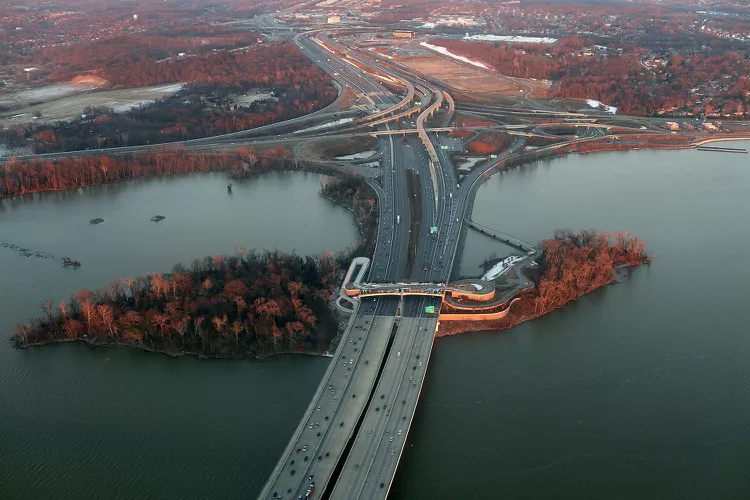1. Overview of the Capital Beltway
2. Getting to Washington, D.C.
3. I-495 History
4. Traffic Congestion on I-495
5. I-495 Driving Tips
6. Virginia Express Lanes on I-495
If you’re on a road trip to Washington, D.C. or have rented a car at the airport, you are likely wondering about how to drive on what locals call the Capital Beltway. It’s actually Interstate 495, a 64-mile highway that encircles Washington. The highway passes through Prince George’s and Montgomery counties in Maryland, and Fairfax County and the city of Alexandria in Virginia.
So I-495 is the Capital Beltway or just “The Beltway.” The two directions of travel, clockwise and counterclockwise, have become known respectively as the “Inner Loop” and the “Outer Loop.” Knowing this terminology is the first step toward navigating this circular road effectively.
Getting to Washington, D.C.
Access to Washington, D.C., is possible via I-270 and I-95 from the north; I-95 and I-295 from the south; I-66 from the west; and U.S. Highway 50 from both the west and the east. Moreover, the most scenic routes from I-495 into Washington include:
- The George Washington Memorial Parkway along the Virginia side of the Potomac River
- The Clara Barton Parkway along the Maryland side of the river
- The Baltimore-Washington Parkway, approaching downtown from the northeast
I-495 History
Construction of the Capital Beltway began in 1955 as part of the Interstate Highway System created by the Federal-Aid Highway Act of 1956. The initial section of the highway opened in 1961, and the entire highway was completed in 1964. Originally, I-95 was planned to serve downtown Washington from both the south and north, intersecting the Beltway in Virginia and Maryland. However, the plan was canceled in 1977, and the completed portion of I-95 inside the Beltway from the south running north into downtown Washington, D.C., was re-designated as I-395.
By 1990, the eastern side of the Beltway was dual-signed I-95/I-495. This change caused some confusion, especially with the exits being renumbered based on I-95’s entry into Maryland at the Woodrow Wilson Bridge.
Traffic Congestion on I-495
The explosive growth of housing and businesses in the Maryland and Virginia suburbs has resulted in heavy traffic around the region, particularly on the Capital Beltway. Despite numerous widening projects over the past few decades, heavy traffic remains a persistent issue.
Notably, the intersections on the Capital Beltway that rank as the “worst bottlenecks in the nation” include:
- The interchange at I-495 and I-270 in Montgomery County, Maryland
- The interchange at I-495 and I-95 in Prince George’s County, Maryland
- The Springfield interchange, where I-395, I-95, and I-495 converge
Consequently, many outlets offer traffic reports featuring real-time information about accidents, road construction, chemical spills, and weather, helping travelers stay informed. Moreover, numerous transportation alternatives exist for commuters who want to avoid the Beltway altogether.
I-495 Driving Tips
Driving on the Capital Beltway and other interstates in the Washington, D.C. area can be quite challenging. Therefore, you can reduce the likelihood of encountering problems by staying informed and planning ahead. Here are some essential tips:
- Plan your route in advance and allow sufficient time to transition to the right-hand lane when exiting. In heavy traffic, lane changes may take longer than expected.
- Traffic conditions can be unpredictable; be flexible and ready to choose an alternate route if needed.
- Avoid traffic congestion by traveling during non-rush-hour periods. Washington rush hour typically runs from 6 to 9 a.m. and 4 to 7 p.m., Monday through Friday.
- Expect backups during rush hour at the Woodrow Wilson Bridge and the American Legion Bridge.
- Construction can cause delays at any time of day. Check state transportation websites before you leave to stay informed about current construction areas.
Virginia Express Lanes on I-495
The Virginia Department of Transportation opened high-occupancy toll (HOT) lanes, or express lanes, in Northern Virginia in 2012. This project included the addition of two lanes to I-495 in each direction from just west of the Springfield interchange to just north of the Dulles Toll Road, along with the replacement of over 50 bridges, overpasses, and major interchanges.
For drivers of vehicles with fewer than three occupants, a toll is required to use these express lanes. An E-Z Pass transponder is necessary for electronic toll collection. Notably, tolls are waived for buses, carpools with at least three people, motorcycles, and emergency vehicles.
If you’re visiting from out of town and possess an E-ZPass from another region, you can also utilize these express lanes. Signs leading up to the toll lanes display the E-ZPass logo, clearly indicating the need for this device. Fortunately, many visitors find it convenient, as 15 states utilize E-ZPass with over 26 million E-ZPass devices in circulation.
However, if you do not have an E-ZPass device, you cannot access the express lanes.





